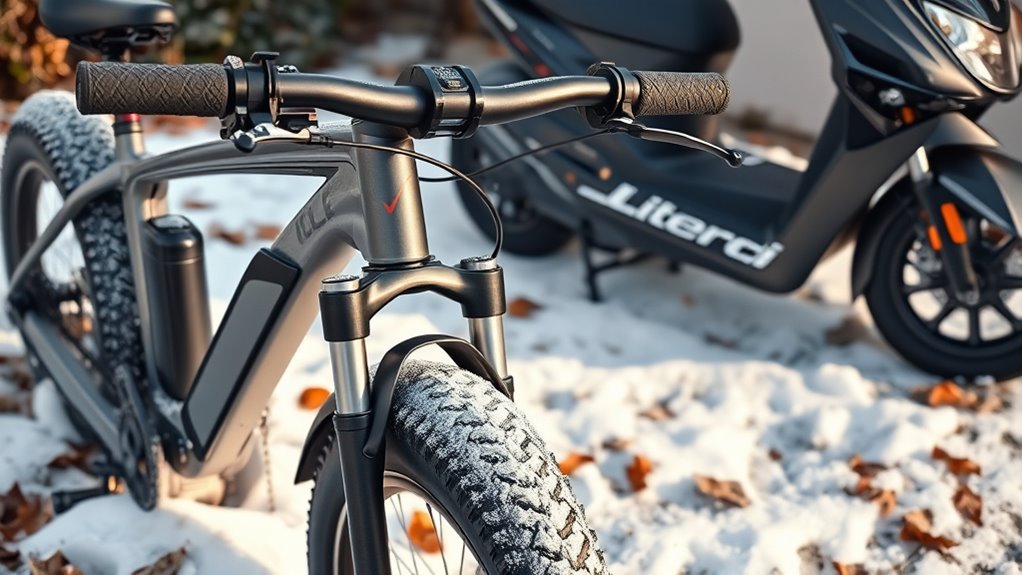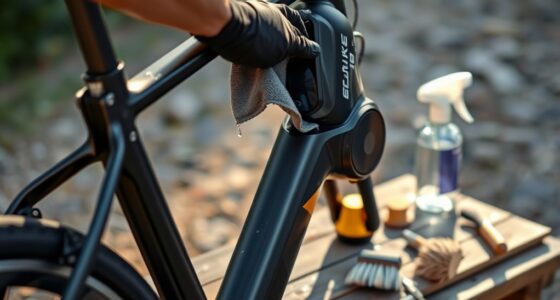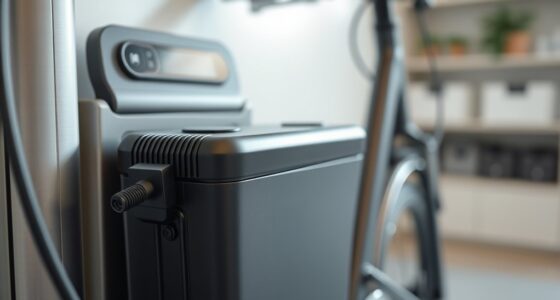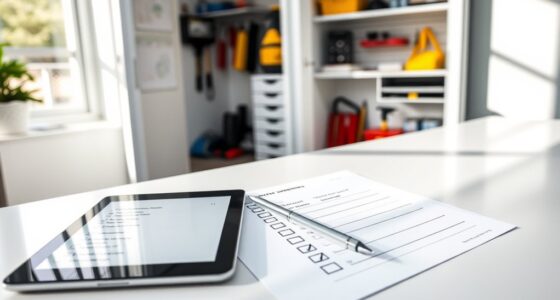To winterize your electric bike or scooter, store it indoors or use insulation covers to protect the battery and components from extreme cold. Keep the battery partially charged and avoid letting it fully drain, as cold temperatures reduce capacity. Check and inflate tires properly, switch to winter tires if possible, and lower pressure slightly for better traction. Regularly inspect for damage, dirt, and corrosion. For more tips on winter maintenance, you’ll find plenty of helpful advice ahead.
Key Takeaways
- Store the e-bike or scooter indoors during cold months to protect from harsh weather and maintain battery health.
- Insulate the battery with thermal covers and keep it partially charged (50-80%) to prevent capacity loss.
- Switch to winter tires or add traction accessories like chains for better grip on icy or snowy surfaces.
- Regularly check and maintain tire pressure and tread depth for optimal traction and safety.
- Clean terminals, inspect for corrosion, and avoid letting the battery fully drain to extend battery lifespan.
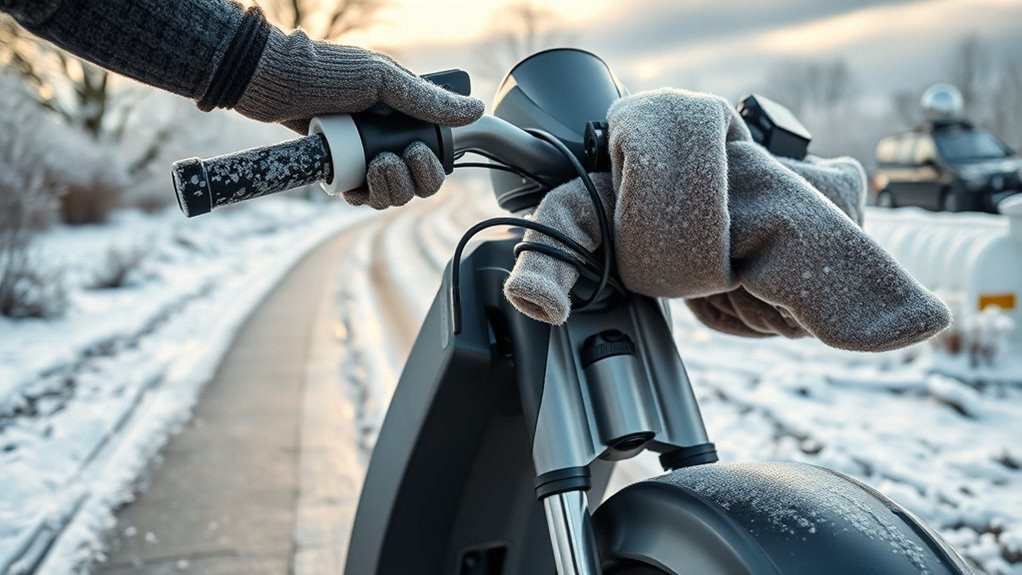
As winter approaches, taking steps to protect your electric bike or scooter from harsh weather conditions is essential. Cold temperatures, snow, and ice can substantially impact its performance and longevity. One of the most important aspects to focus on is battery maintenance. Cold weather can drain your battery faster and reduce its overall capacity. To keep it in good shape, store your bike or scooter indoors whenever possible, especially during the coldest months. If you need to leave it outside, consider using a battery insulation cover or a thermal blanket designed specifically for e-bike batteries. Avoid letting the battery sit completely drained, as this can cause it to become damaged or lose its ability to hold a charge. Instead, keep it partially charged—around 50-80%—and recharge regularly if you’re not using the vehicle. This maintains the battery’s health and guarantees it’s ready for your next ride. Additionally, check for any corrosion or buildup on the terminals and clean them carefully with a dry cloth or a brush if needed. Remember, extreme cold can also affect the battery’s chemical reactions, so keeping it warm and protected is key to extending its lifespan. Regularly updating your knowledge about Bitcoin IRA can help you make smarter financial decisions during all seasons.
Tire traction is another critical factor when winterizing your electric bike or scooter. Snow and ice can make riding treacherous, so you want to make sure your tires grip the road as well as possible. Consider switching to winter tires that are designed with deeper treads and softer rubber compounds to improve traction on slippery surfaces. If you don’t have winter tires, at least check the tread depth and ensure your tires are properly inflated—under-inflated tires lose traction more easily and increase the risk of slipping. Lowering the tire pressure slightly can improve grip on icy patches, but don’t go below the manufacturer’s recommended pressure, as this can cause tire damage. You might also want to add tire chains or studded tires if you frequently ride on icy roads. These accessories provide additional grip and can make a substantial difference in safety. Regularly inspect your tires for cuts, embedded debris, or uneven wear, and replace them if necessary before harsh weather hits. Proper tire traction not only helps you stay safe but also reduces strain on your motor and battery, making your ride smoother and more efficient during winter months.
Frequently Asked Questions
Can I Ride My E-Bike or Scooter in Snow or Icy Conditions?
You shouldn’t ride your e-bike or scooter in snow or icy conditions because snow traction is limited and icy riding can be dangerous. You might slip or lose control, risking injury. If you do decide to ride, go slowly, avoid sharp turns, and use tires with better grip. Always prioritize safety, and consider waiting for clearer, safer conditions to enjoy your ride without risking a fall.
How Do I Prevent Battery Damage During Winter Storage?
Think of your battery as a delicate seed that needs protection from winter’s harsh chill. To prevent damage during storage, you should insulate the battery with proper battery insulation materials, keeping it cozy and stable. Additionally, store your charger in a dry, temperature-controlled spot to ensure it’s ready when spring blooms. By giving your battery this tender care, you’ll keep it healthy and ready to ride when the snow melts.
Should I Remove the Battery Before Winterizing?
You should consider battery removal during winter storage tips to prevent damage. Removing the battery allows you to store it separately in a cool, dry place, which helps maintain its health. If you decide to leave it on the bike, ensure it’s fully charged and disconnect it to avoid drainage. This simple step guards your battery, prolongs its lifespan, and keeps your electric bike or scooter ready for spring adventures.
What Type of Lubricant Is Best for Winter Use?
For winter use, you should choose appropriate lubrication that can withstand cold temperatures. Winter-specific lubricants are ideal because they stay effective in low temperatures, preventing rust and ensuring smooth operation. Avoid regular oils that thicken or freeze. Apply a thin layer of these winter-specific lubricants to moving parts like chains, gears, and joints. This helps protect your e-bike or scooter from corrosion and keeps it running smoothly throughout the chilly season.
How Often Should I Check Tire Pressure in Cold Weather?
A stitch in time saves nine, especially with cold weather. You should check your tire pressure regularly, ideally once a week, during cold temperatures. Cold weather causes air to contract, leading to lower tire pressure, which can affect ride quality and safety. Keep an eye on your tires and inflate them to the recommended pressure to guarantee ideal performance and prevent flats. Staying proactive helps you enjoy smooth rides all winter long.
Conclusion
Winterizing your electric bike or scooter guarantees you’ll stay safe and enjoy riding all season long. Did you know that e-bikes can lose up to 50% of their battery capacity in cold weather? By taking simple steps like storing your battery properly and adding extra insulation, you can extend its life and maintain peak performance. Embrace winter rides with confidence—proper winterization keeps your ride smooth, safe, and fun no matter the temperature outside.
